BBC Earth newsletter
BBC Earth delivered direct to your inbox
Sign up to receive news, updates and exclusives from BBC Earth and related content from BBC Studios by email.
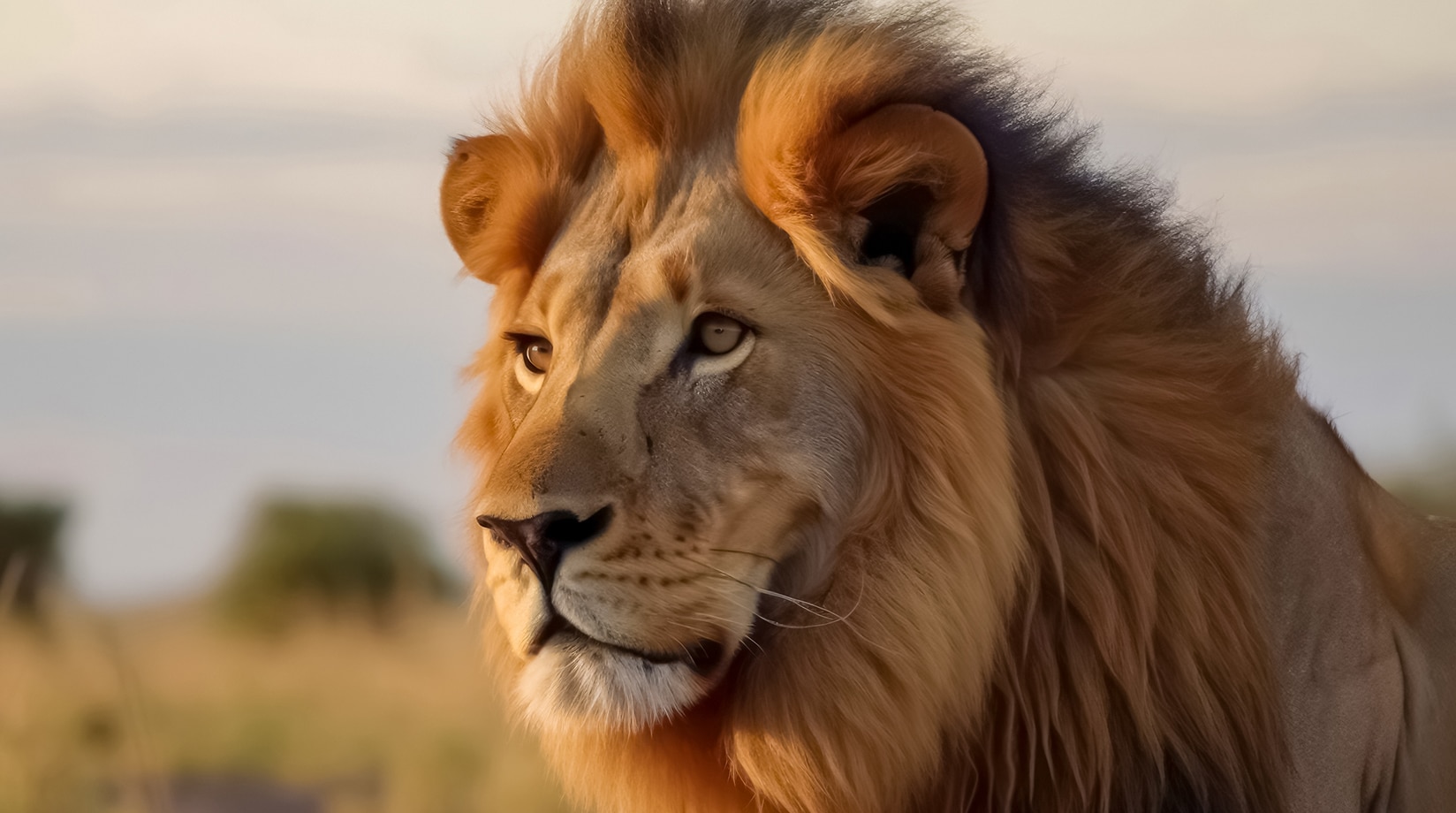
The lion is the second biggest big cat after the tiger. Unlike most big cats, the lion is social, and lives in family groups called prides. This ferocious apex predator works together with its companions to take down sizeable prey like water buffalo, which are much larger than a single lion.
As with tigers, the taxonomy of lion subspecies is a little contentious. Historically, lion "types" were divided into the African lion and the Asiatic lion.4 However, genetic studies have more recently established that lions living in India are more closely related to the lions living in Central and West Africa than to those living in Southern or Eastern Africa. It is thought that the two subspecies overlap in Ethiopia, Sudan and South Sudan.
Lions are possibly one of the most recognisable animals on the planet, with one of their most distinctive features being their mane. Only males can grow a mane, which can measure up to 68cm (27 inches) long, but varies greatly between individuals.5 However, some male lions remain maneless. This phenomenon is more common among populations living in the Kalahari desert and might represent an evolutionary adaptation to the warmer climate.
The mane serves various purposes. It may offer protection to the male lion’s neck from the teeth and claws of rivals during a fight. Darker manes indicate a better quality diet and more testosterone and females could be using this information to choose their mate – there is evidence that darker-maned lions have more reproductive success.6 But having a bigger and darker mane comes at a cost – owning one can make the lion hotter. Mane length might also indicate fighting ability, and can be used by other males to work out if they stand a chance in a fight.7
Like tigers, lions can be split into subspecies. There is the Panthera leo leo, found in India, Central and West Africa; and Panthera leo melanochaita, which inhabits regions of Southern and East Africa.
Lions have adapted to living in warmer climates in other ways. Males rest for up to 20 hours a day, with females resting for slightly fewer hours.8 They do most of their activity, like hunting, at night as being active then means that they avoid the hottest parts of the day. A lion’s eyes are also specially adapted to hunt at night. White strips of fur on their bottom eyelids are thought to help reflect light up into their eye to make it easier to see in moonlight. Lions have sensitive hearing which means they can detect prey from a mile away.
Lions are also able to survive for long periods of time without drinking water. Instead, they can obtain fluids from the animals that they eat and also from some plants.9 This enables them to live in some of the most challenging environments in Africa, such as the Kalahari desert, and at elevations of over 4,000m (13,123ft) in Ethiopia, where there is less rainfall.
Like most cats, lions can retract their claws to keep them sharp. They measure up to 4cm (1.5 inches) long and are razor sharp, which makes them perfect for clinging onto fleeing prey. Lions use their strength and weight to pull their prey down.
Lions are also the only cat to have a tassel on the end of their tail. It’s thought that they use this tassel to communicate by pointing, or as a way of flirting.
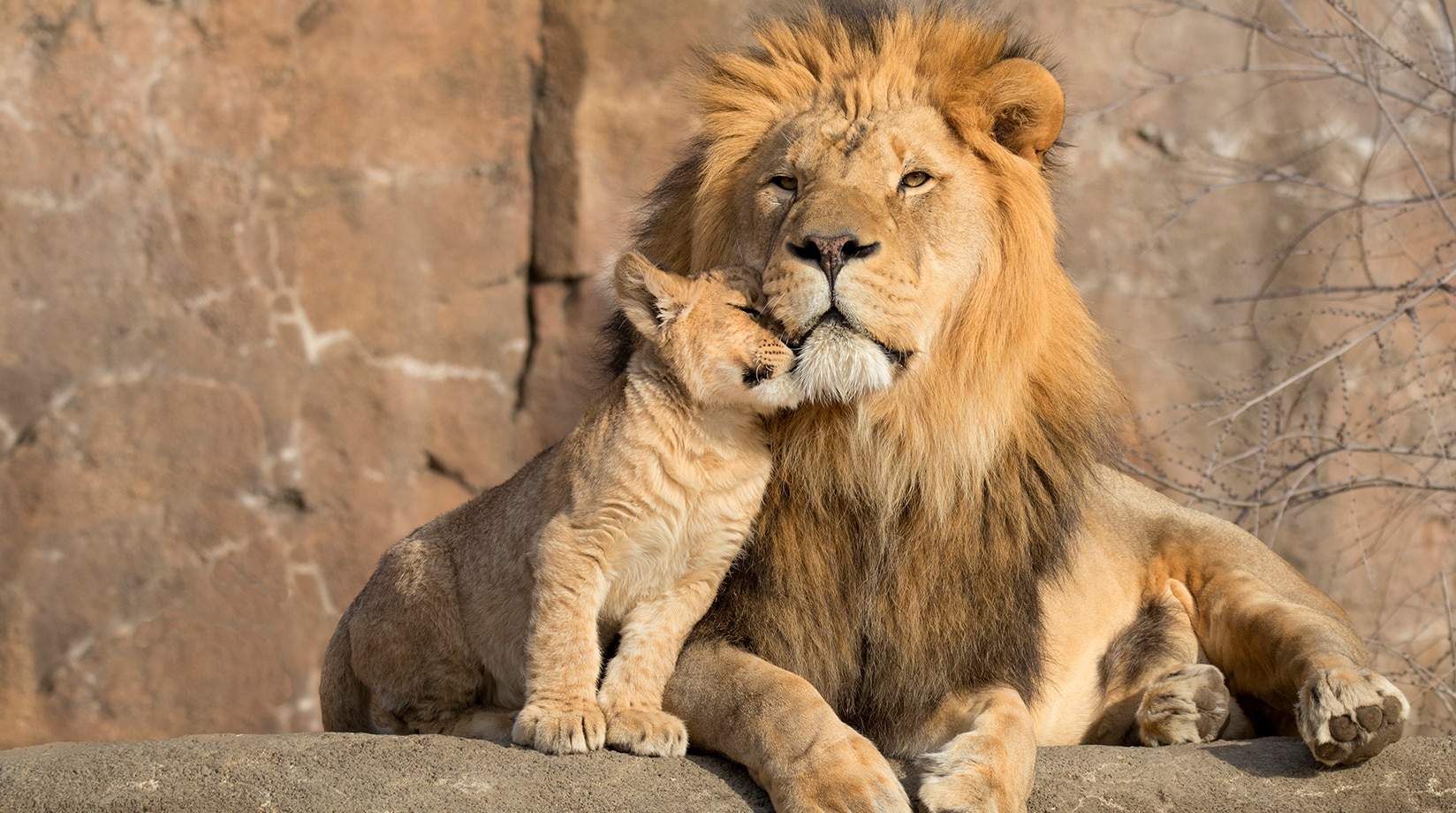
Lions hunt prey, which ranges from prickly porcupines the size of a small dog to adult giraffes measuring 4-5m tall.10 Incredibly, they have even been cases of lions hunting cape fur seals on Namibia’s Skeleton Coast.11 They have also been known to eat ostriches, aardvarks, crocodiles and tortoises. They’re really not picky eaters!
Lions are opportunists, scavenging where possible. They will also take kills from other predators such as leopards, painted dogs or hyenas, using their size and group numbers to scare away their competition. In rare circumstances, lions have been known to kill their own cubs and eat them.
Most lion hunts take place at night. They walk up to 12km (7.5 miles) in search of food. But in extreme cases, lions might walk over 40km (around the distance of a marathon) in one night.
After a big kill, lions remain by the carcass for up to two days to consume as much as possible and to fend off scavengers. So, lions walk less after a successful hunt and walk more when unsuccessful. Successful lions can make up to 50 kills a year.
Even young lions can cover big distances on foot. Six-month-old cubs can walk 9km (5.6 miles) each night – almost as far as their parents! When they are a few months old, cubs follow their parents on searches for food, but hide during the pursuit and are collected once the hunt is over.
How successful are lion hunts? It can be hard to quantify what denotes a successful hunt as there is evidence that lions from different regions have different hunting strategies. For instance, prides from the Kalahari seem to favour hunting smaller prey, compared to lions from the Serengeti and Kruger national parks who seek out larger prey.
It’s thought that lions can eat the equivalent of one-fifth of their body weight in one meal. But on average, females eat 5kg and males 7.2kg daily.12
After feeding, a lion can survive for over a week without needing to eat again.
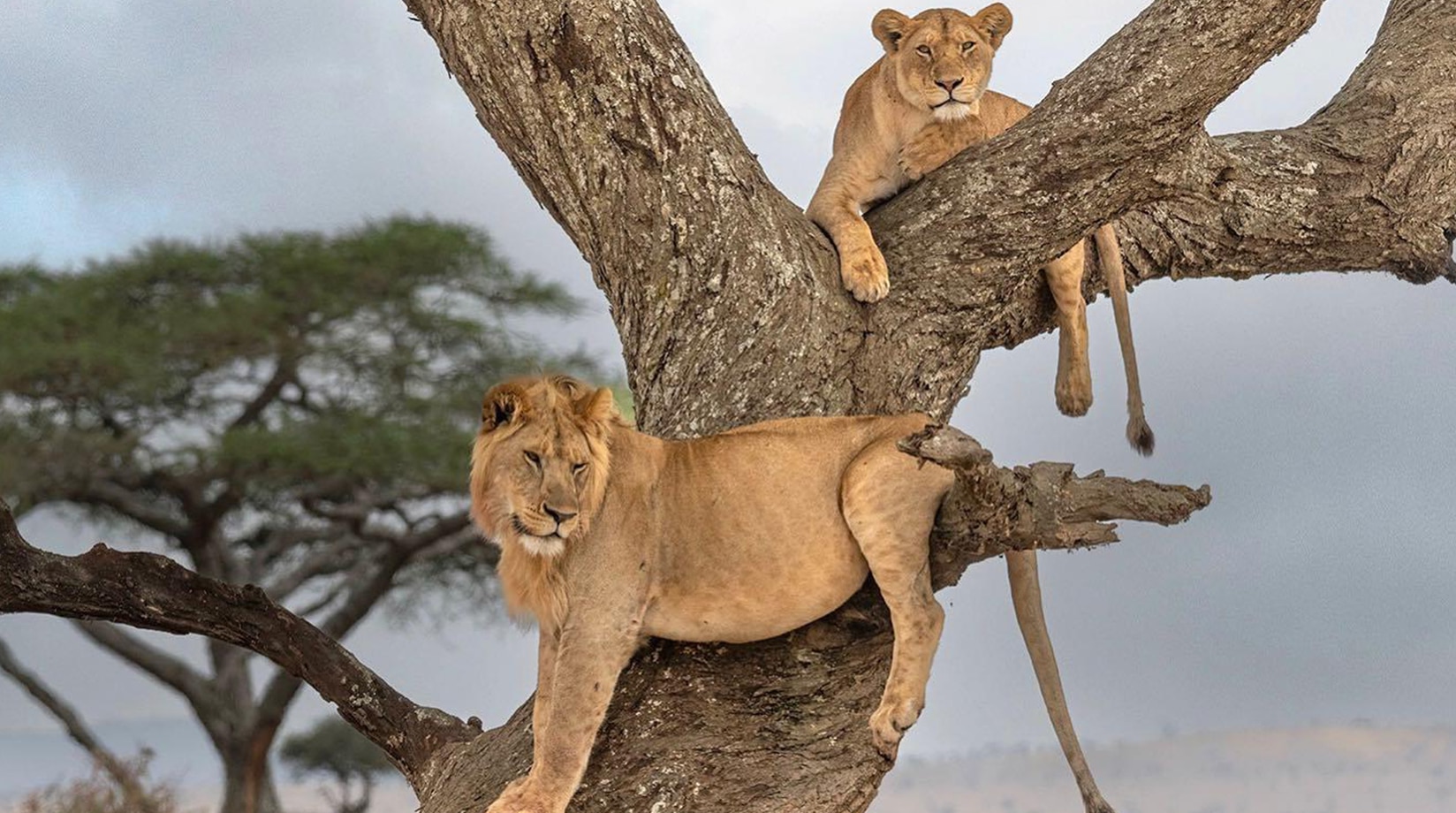
Lions are a social species who live in large family groups called "prides". This makes them unusual in the cat world. The only other cat species which socialises and hunts together is the cheetah, and even then it is only the male cheetahs that do so.13
Prides vary in size, but commonly comprise between 5 and 20 individuals, sometimes rising to as many as 30. Many lion hunts are solo endeavours, but they team up to hunt larger prey. The larger the group, the more successful the lions are at hunting.
Lions are not fast runners, nor do they have the stamina to sprint for more than a few minutes, so they have to use other strategies to catch their prey. Like other big cats, lions hunt by stealth. Often operating under the cover of darkness, lions silently stalk large prey, keeping their distance and remaining downwind in order to avoid drawing attention to themselves.
Males tend to hunt in smaller groups than females, and the two sexes use different strategies. Females use their numbers to their advantage, coordinating their attack together, whereas males rely more on ambush and hunt in areas with dense vegetation.14
Once within 50m (164ft) of their prey, they strike. A smaller group makes the first move, forcing the prey to run towards a second group lying in wait. The lions leap onto their prey and drag the animal down with their powerful claws. Once subdued, the prey is asphyxiated with a bite to the throat.
There is some evidence that lions have a preferred role in the hunt – and are more successful when undertaking this preferred role.15
When hunting herd animals like zebra, antelope and wildebeest, the pride will select a weak link – perhaps a younger or older individual who might be easier to catch.
Female lions more often target small- to medium-sized prey, such as springbok. Males, who are larger and stronger than their female counterparts, more frequently take on bigger animals like giraffes, wildebeest and buffalo.
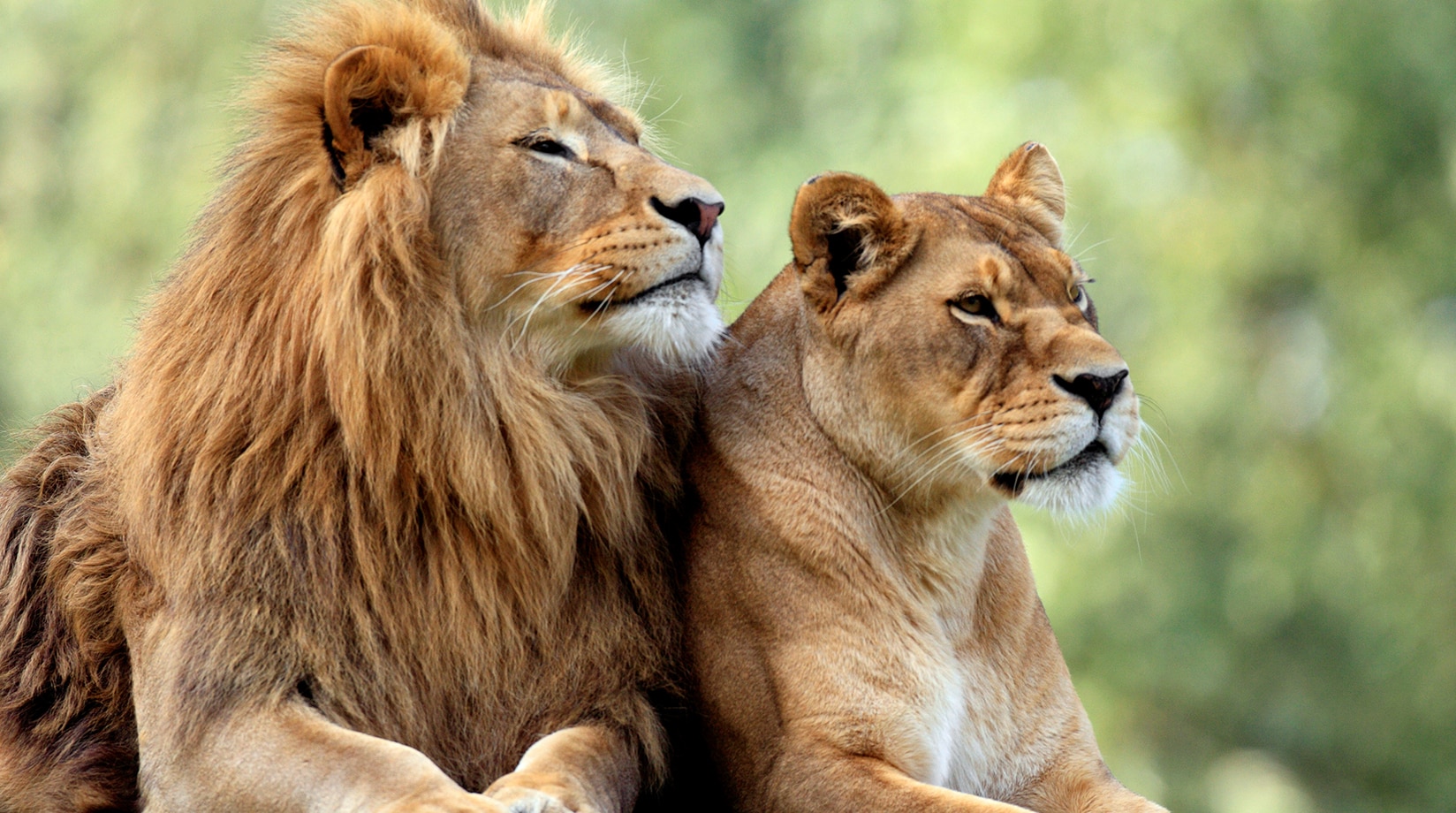
While lions can call at least 23 countries home, their range has dramatically decreased in recent times. Climate change, human settlements and roads, agriculture and poaching have all led to fragmentation of the lion’s habitat. Their current range is thought to amount to about 7.4% of its historic total.16
Lions once ranged over the whole African continent, to Europe and across southwest Asia into India. However, they have long been extinct in many of these areas. They were hunted to extinction in Europe at least 2,000 years ago.
Their numbers declined most rapidly in the 20th century. In the 1950s, there could have been as many as 500,000 lions.17 Today, there is thought to be around 23,000 left in Africa and 670 in India.
Habitat loss is the largest cause of the decline in lion numbers. This doesn’t just affect lions – who need large areas of savannah to hunt – but also their prey, whose numbers are declining too.
The fragmentation of lion populations is making it challenging to protect them. In some areas of West Africa, for example, populations number fewer than 50 individuals. Many of these small groups have no way of spreading into new areas as their habitats are being entirely cut off by human settlements, roads, infrastructure and agriculture. And cubs suffer greatly from the loss of prey and habitat – in some lion populations, only 5% of cubs survive their first year.18
Lions are also most at risk in west Africa, where they could be considered critically endangered. However, wildlife tourism, regulated trophy hunting and habitat protection are helping lion numbers to stay steady in East and Southern Africa.
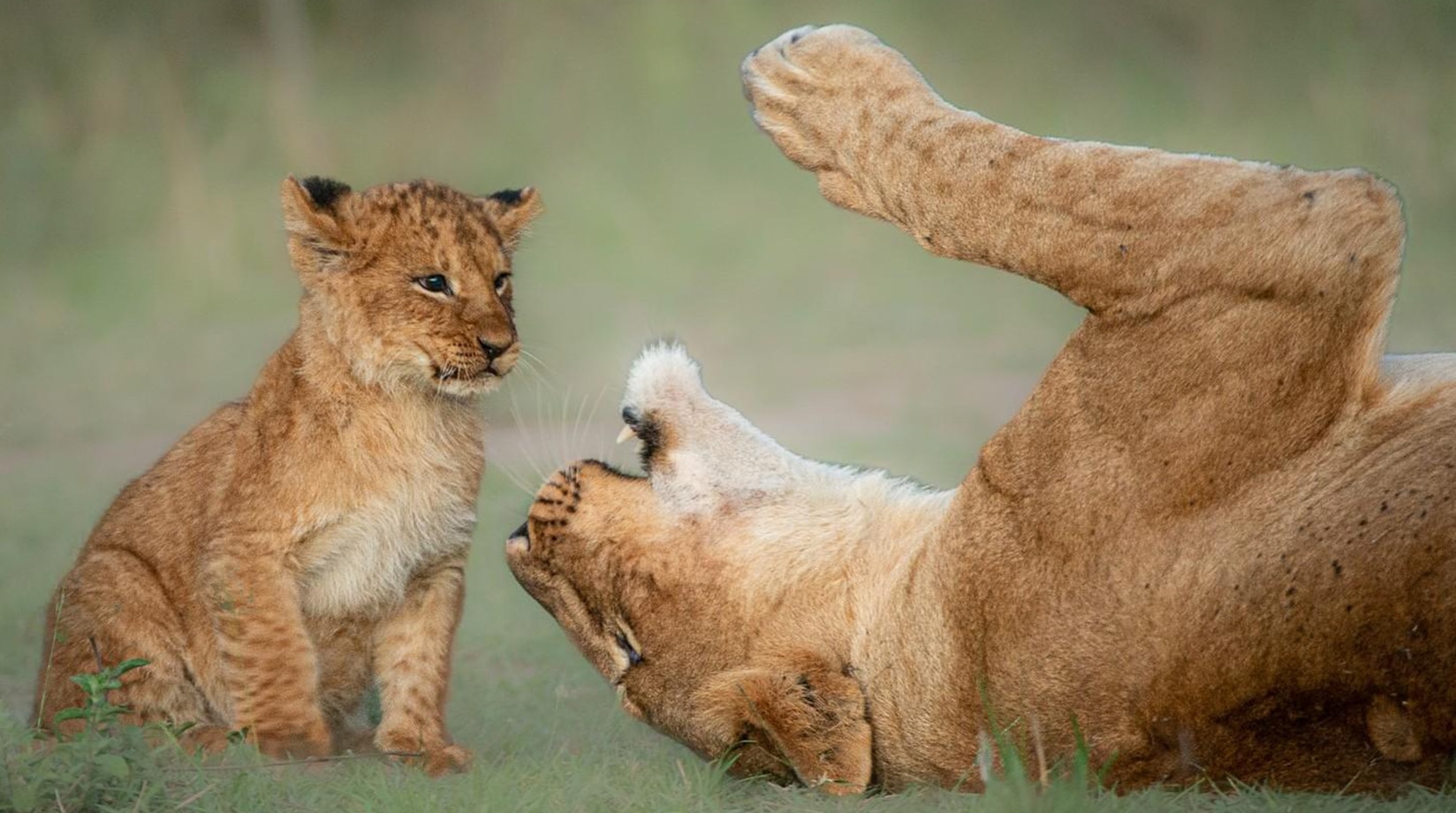
Lions' iconic roars serve many purposes. Firstly, they act as a warning to other prides. When a pride encounters an unfamiliar lion or another pride, they first signal their awareness with a roar. Lions defending their territory from intruders will roar more frequently when they outnumber the unfamiliar pride.19
Lions roar more often when inside their home ranges than when straying into unknown territory. This might be a way to avoid drawing attention to themselves in order to minimise the chance of a fight with another pride. Lions roar more during the night when they are most active.
They can tell how many lions are in a pride based on their roars. They might not be able to hear different individuals’ unique roars, but they respond to the boldness of the roars. The more lions in a pride, the bolder their behaviour.20
Lions can hear each others’ roars for miles around, so may be able to scare off opponents before they even come into view. At its loudest, a lion’s roar can reach 114 decibels – roughly the equivalent of a very loud rock concert! 21
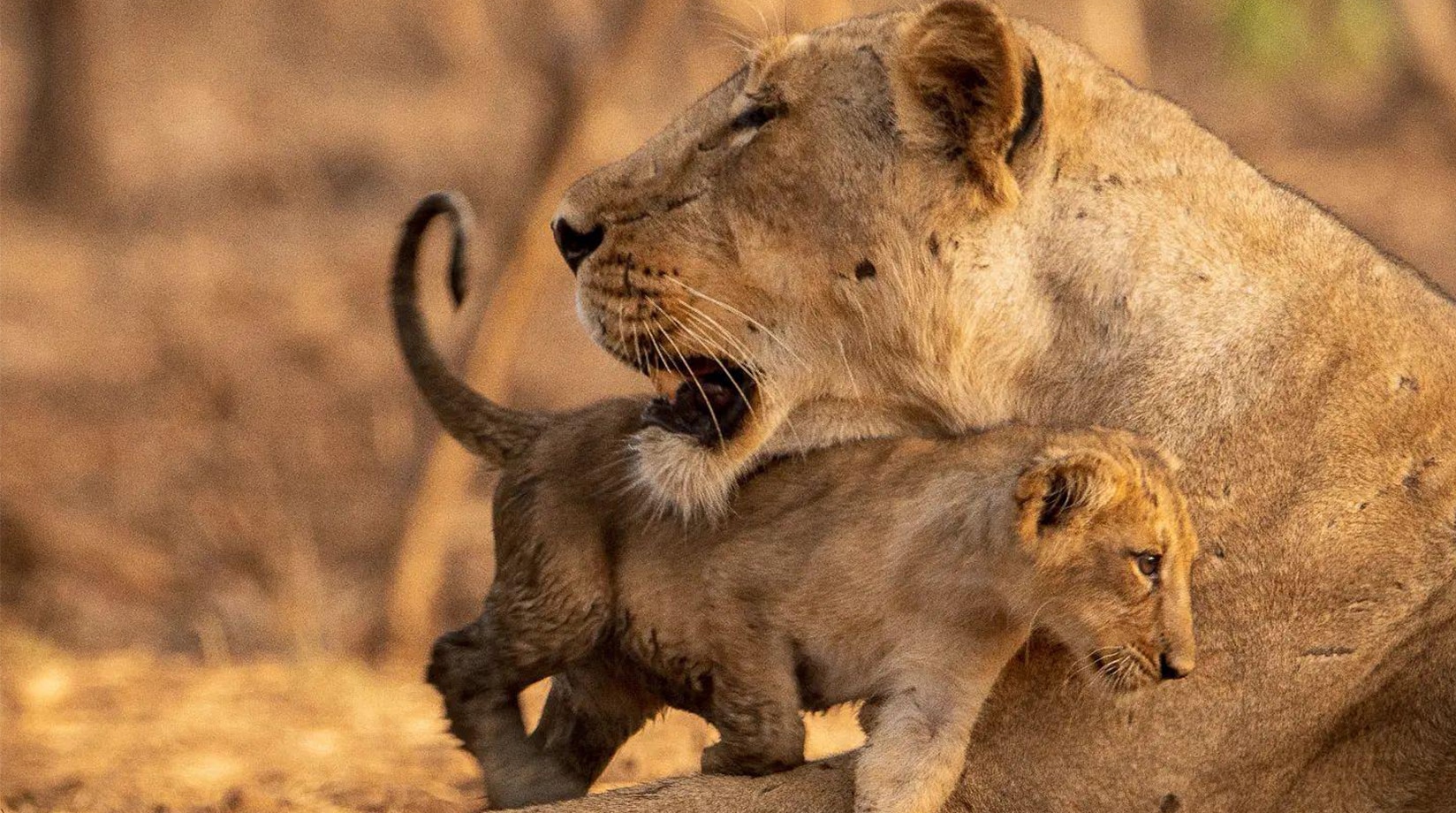
Featured image © MP_Foto
Fun fact image © Keyur Nandaniya | Unsplash
1. Eloff, F. C. 1998. “THE LIFE of the KALAHARI LION (PANTHERA LEO VERNAYI).” Transactions of the Royal Society of South Africa 53 (2): 267–69. https://doi.org/10.1080/00359199809520393.
2. Ikanda, Dennis, Paolo Strampelli (Panthera, Samantha K Nicholson, Guillaume, SSC Cat, Meena, Pricelia Fobuzie Tumenta (ALWG, Andrew Loveridge, and Hans Bauer (WildCRU. 2023. “IUCN Red List of Threatened Species: Panthera Leo.” IUCN Red List of Threatened Species. Name. February 2023. https://www.iucnredlist.org/species/15951/231696234.
3. Williams, Leah J., Katherine Finch, Rose Agnew, and Lisa Holmes. 2021. “Effects of Nearby Construction Work on the Behavior of Asiatic Lions (Panthera Leo Persica).” Journal of Zoological and Botanical Gardens 2 (1): 66–74. https://doi.org/10.3390/jzbg2010005.
4. Ikanda, Dennis, Paolo Strampelli (Panthera, Samantha K Nicholson, Guillaume, SSC Cat, Meena, Pricelia Fobuzie Tumenta (ALWG, Andrew Loveridge, and Hans Bauer (WildCRU. 2023. “IUCN Red List of Threatened Species: Panthera Leo.” IUCN Red List of Threatened Species. Name. February 2023. https://www.iucnredlist.org/species/15951/231696234#:~:text=AVAILABLE%2….
5. Trethowan, Paul, Andrea Fuller, Anna Haw, Tom Hart, Andrew Markham, Andrew Loveridge, Robyn Hetem, Byron du Preez, and David W. Macdonald. 2016. “Getting to the Core: Internal Body Temperatures Help Reveal the Ecological Function and Thermal Implications of the Lions’ Mane.” Ecology and Evolution 7 (1): 253–62. https://doi.org/10.1002/ece3.2556.
6. West, P. M. 2002. “Sexual Selection, Temperature, and the Lion’s Mane.” Science 297 (5585): 1339–43. https://doi.org/10.1126/science.1073257.
7. West, P. M. 2002. “Sexual Selection, Temperature, and the Lion’s Mane.” Science 297 (5585): 1339–43. https://doi.org/10.1126/science.1073257.
8. Ikanda, Dennis, Paolo Strampelli (Panthera, Samantha K Nicholson, Guillaume, SSC Cat, Meena, Pricelia Fobuzie Tumenta (ALWG, Andrew Loveridge, and Hans Bauer (WildCRU. 2023. “IUCN Red List of Threatened Species: Panthera Leo.” IUCN Red List of Threatened Species. Name. February 2023. https://www.iucnredlist.org/species/15951/231696234#:~:text=AVAILABLE%2…-.
9. Dunston, Emma J., Jackie Abell, Rebecca E. Doyle, Megan Evershed, and Rafael Freire. 2016. “Exploring African Lion (Panthera Leo) Behavioural Phenotypes: Individual Differences and Correlations between Sociality, Boldness and Behaviour.” Journal of Ethology 34 (3): 277–90. https://doi.org/10.1007/s10164-016-0473-9.
10. Eloff, F. C. 1984. “Food Ecology of the Kalahari Lion Panthera Leo Vernayi.” Koedoe 27 (2): 249–58. https://koedoe.co.za/index.php/koedoe/article/view/584/613.
11. Ikanda, Dennis, Paolo Strampelli (Panthera, Samantha K Nicholson, Guillaume, SSC Cat, Meena, Pricelia Fobuzie Tumenta (ALWG, Andrew Loveridge, and Hans Bauer (WildCRU. 2023. “IUCN Red List of Threatened Species: Panthera Leo.” IUCN Red List of Threatened Species. Name. February 2023. https://www.iucnredlist.org/species/15951/231696234#:~:text=AVAILABLE%2…-.
12. Eloff, F. C. 1984. “Food Ecology of the Kalahari Lion Panthera Leo Vernayi.” Koedoe 27 (2): 249–58. https://koedoe.co.za/index.php/koedoe/article/view/584/613.
13. Stander1, P, and S Albon2. 1993. “Hunting Success of Lions in a Semi-Arid Environment.” Symp. Zoo!. Soc. Lond 65: 127–43. http://the-eis.com/elibrary/sites/default/files/downloads/literature/Hu….
14. Loarie, Scott R., Craig J. Tambling, and Gregory P. Asner. 2013. “Lion Hunting Behaviour and Vegetation Structure in an African Savanna.” Animal Behaviour 85 (5): 899–906. https://doi.org/10.1016/j.anbehav.2013.01.018.
15. Stander, P.E. 1992. “Cooperative Hunting in Lions: The Role of the Individual.” Behavioral Ecology and Sociobiology 29 (6). https://doi.org/10.1007/bf00170175.
16. Ikanda, Dennis, Paolo Strampelli (Panthera, Samantha K Nicholson, Guillaume, SSC Cat, Meena, Pricelia Fobuzie Tumenta (ALWG, Andrew Loveridge, and Hans Bauer (WildCRU. 2023. “IUCN Red List of Threatened Species: Panthera Leo.” IUCN Red List of Threatened Species. Name. February 2023. https://www.iucnredlist.org/species/15951/231696234#:~:text=AVAILABLE%2…-.
17. Dunston, Emma J., Jackie Abell, Rebecca E. Doyle, Megan Evershed, and Rafael Freire. 2016. “Exploring African Lion (Panthera Leo) Behavioural Phenotypes: Individual Differences and Correlations between Sociality, Boldness and Behaviour.” Journal of Ethology 34 (3): 277–90. https://doi.org/10.1007/s10164-016-0473-9.
18. Eloff, F. C. 1998. “THE LIFE of the KALAHARI LION (PANTHERA LEO VERNAYI).” Transactions of the Royal Society of South Africa 53 (2): 267–69. https://doi.org/10.1080/00359199809520393.
19. Huang, Joshua, ed. n.d. Review of Lion Vocalization Behaviour in Territorial Defence - a TikTok Crash Course. Zoology 567.
20. Dunston, Emma J., Jackie Abell, Rebecca E. Doyle, Megan Evershed, and Rafael Freire. 2016. “Exploring African Lion (Panthera Leo) Behavioural Phenotypes: Individual Differences and Correlations between Sociality, Boldness and Behaviour.” Journal of Ethology 34 (3): 277–90. https://doi.org/10.1007/s10164-016-0473-9.
21. BBC. 2019. “Radio 4 in Four - Nine Roar-Some Facts about Lions.” BBC. BBC. July 19, 2019. https://www.bbc.co.uk/programmes/articles/1WXqfwCNlzqwLTQfMTDSgY5/nine-….
The lion is the second biggest big cat after the tiger. Unlike most big cats, the lion is social, and lives in family groups called prides. This ferocious apex predator works together with its companions to take down sizeable prey like water buffalo, which are much larger than a single lion.
Cub
Pride
Most commonly zebra, wildebeest and antelope
Humans
In the wild, males typically live up to 16 years, with females generally living slightly longer1
5.6-8.3 feet (male), or 4.6-5.7 feet (female)
On average, 130-190kg
Sub-Saharan Africa and India
23,000, as of February 20232
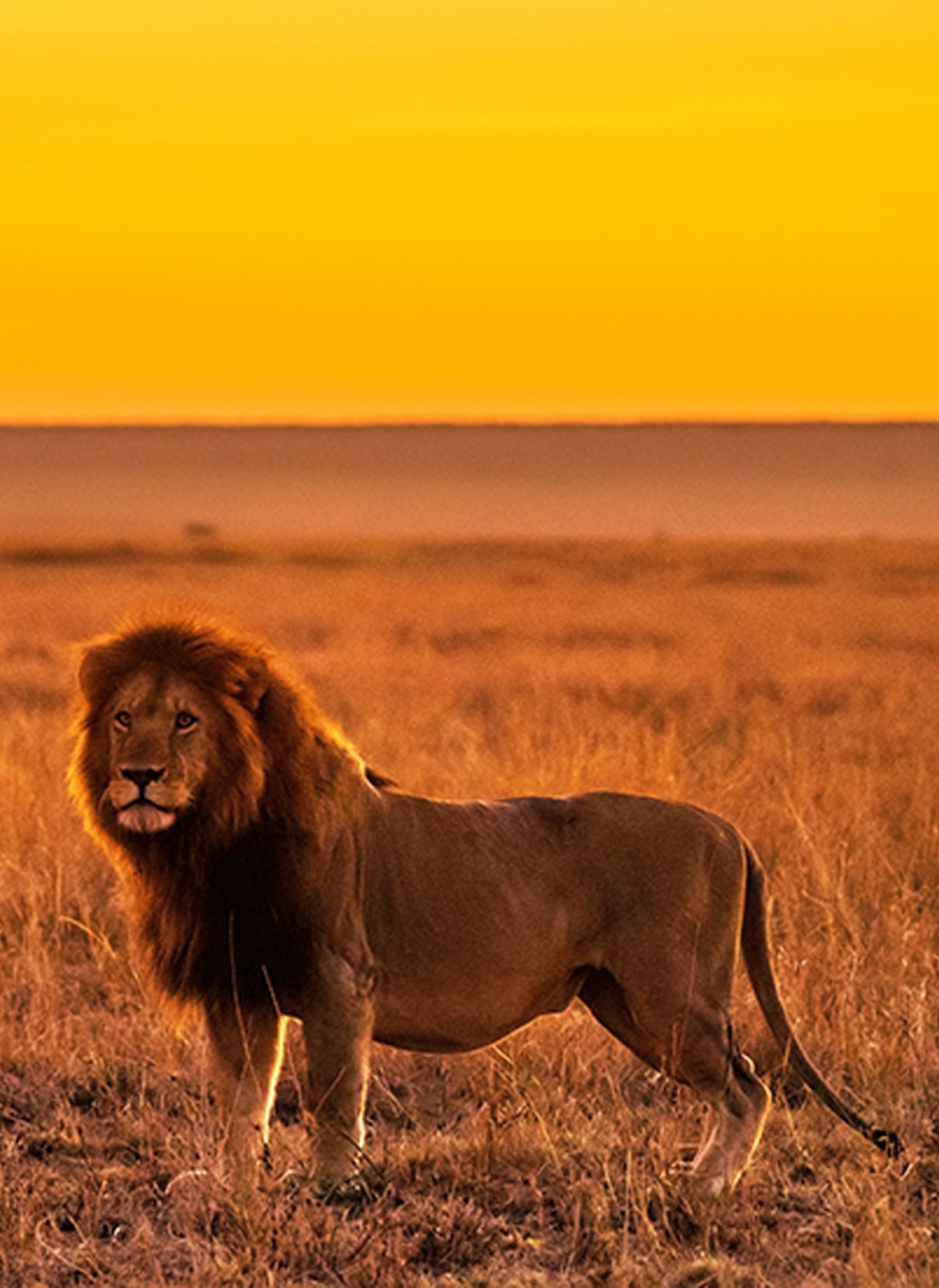
The darker a lion’s mane, the more attractive he is to females.
As with tigers, the taxonomy of lion subspecies is a little contentious. Historically, lion "types" were divided into the African lion and the Asiatic lion.4 However, genetic studies have more recently established that lions living in India are more closely related to the lions living in Central and West Africa than to those living in Southern or Eastern Africa. It is thought that the two subspecies overlap in Ethiopia, Sudan and South Sudan.
Lions are possibly one of the most recognisable animals on the planet, with one of their most distinctive features being their mane. Only males can grow a mane, which can measure up to 68cm (27 inches) long, but varies greatly between individuals.5 However, some male lions remain maneless. This phenomenon is more common among populations living in the Kalahari desert and might represent an evolutionary adaptation to the warmer climate.
The mane serves various purposes. It may offer protection to the male lion’s neck from the teeth and claws of rivals during a fight. Darker manes indicate a better quality diet and more testosterone and females could be using this information to choose their mate – there is evidence that darker-maned lions have more reproductive success.6 But having a bigger and darker mane comes at a cost – owning one can make the lion hotter. Mane length might also indicate fighting ability, and can be used by other males to work out if they stand a chance in a fight.7
Like tigers, lions can be split into subspecies. There is the Panthera leo leo, found in India, Central and West Africa; and Panthera leo melanochaita, which inhabits regions of Southern and East Africa.
Lions have adapted to living in warmer climates in other ways. Males rest for up to 20 hours a day, with females resting for slightly fewer hours.8 They do most of their activity, like hunting, at night as being active then means that they avoid the hottest parts of the day. A lion’s eyes are also specially adapted to hunt at night. White strips of fur on their bottom eyelids are thought to help reflect light up into their eye to make it easier to see in moonlight. Lions have sensitive hearing which means they can detect prey from a mile away.
Lions are also able to survive for long periods of time without drinking water. Instead, they can obtain fluids from the animals that they eat and also from some plants.9 This enables them to live in some of the most challenging environments in Africa, such as the Kalahari desert, and at elevations of over 4,000m (13,123ft) in Ethiopia, where there is less rainfall.
Like most cats, lions can retract their claws to keep them sharp. They measure up to 4cm (1.5 inches) long and are razor sharp, which makes them perfect for clinging onto fleeing prey. Lions use their strength and weight to pull their prey down.
Lions are also the only cat to have a tassel on the end of their tail. It’s thought that they use this tassel to communicate by pointing, or as a way of flirting.

Lions hunt prey, which ranges from prickly porcupines the size of a small dog to adult giraffes measuring 4-5m tall.10 Incredibly, they have even been cases of lions hunting cape fur seals on Namibia’s Skeleton Coast.11 They have also been known to eat ostriches, aardvarks, crocodiles and tortoises. They’re really not picky eaters!
Lions are opportunists, scavenging where possible. They will also take kills from other predators such as leopards, painted dogs or hyenas, using their size and group numbers to scare away their competition. In rare circumstances, lions have been known to kill their own cubs and eat them.
Most lion hunts take place at night. They walk up to 12km (7.5 miles) in search of food. But in extreme cases, lions might walk over 40km (around the distance of a marathon) in one night.
After a big kill, lions remain by the carcass for up to two days to consume as much as possible and to fend off scavengers. So, lions walk less after a successful hunt and walk more when unsuccessful. Successful lions can make up to 50 kills a year.
Even young lions can cover big distances on foot. Six-month-old cubs can walk 9km (5.6 miles) each night – almost as far as their parents! When they are a few months old, cubs follow their parents on searches for food, but hide during the pursuit and are collected once the hunt is over.
How successful are lion hunts? It can be hard to quantify what denotes a successful hunt as there is evidence that lions from different regions have different hunting strategies. For instance, prides from the Kalahari seem to favour hunting smaller prey, compared to lions from the Serengeti and Kruger national parks who seek out larger prey.
It’s thought that lions can eat the equivalent of one-fifth of their body weight in one meal. But on average, females eat 5kg and males 7.2kg daily.12
After feeding, a lion can survive for over a week without needing to eat again.

Lions are a social species who live in large family groups called "prides". This makes them unusual in the cat world. The only other cat species which socialises and hunts together is the cheetah, and even then it is only the male cheetahs that do so.13
Prides vary in size, but commonly comprise between 5 and 20 individuals, sometimes rising to as many as 30. Many lion hunts are solo endeavours, but they team up to hunt larger prey. The larger the group, the more successful the lions are at hunting.
Lions are not fast runners, nor do they have the stamina to sprint for more than a few minutes, so they have to use other strategies to catch their prey. Like other big cats, lions hunt by stealth. Often operating under the cover of darkness, lions silently stalk large prey, keeping their distance and remaining downwind in order to avoid drawing attention to themselves.
Males tend to hunt in smaller groups than females, and the two sexes use different strategies. Females use their numbers to their advantage, coordinating their attack together, whereas males rely more on ambush and hunt in areas with dense vegetation.14
Once within 50m (164ft) of their prey, they strike. A smaller group makes the first move, forcing the prey to run towards a second group lying in wait. The lions leap onto their prey and drag the animal down with their powerful claws. Once subdued, the prey is asphyxiated with a bite to the throat.
There is some evidence that lions have a preferred role in the hunt – and are more successful when undertaking this preferred role.15
When hunting herd animals like zebra, antelope and wildebeest, the pride will select a weak link – perhaps a younger or older individual who might be easier to catch.
Female lions more often target small- to medium-sized prey, such as springbok. Males, who are larger and stronger than their female counterparts, more frequently take on bigger animals like giraffes, wildebeest and buffalo.

While lions can call at least 23 countries home, their range has dramatically decreased in recent times. Climate change, human settlements and roads, agriculture and poaching have all led to fragmentation of the lion’s habitat. Their current range is thought to amount to about 7.4% of its historic total.16
Lions once ranged over the whole African continent, to Europe and across southwest Asia into India. However, they have long been extinct in many of these areas. They were hunted to extinction in Europe at least 2,000 years ago.
Their numbers declined most rapidly in the 20th century. In the 1950s, there could have been as many as 500,000 lions.17 Today, there is thought to be around 23,000 left in Africa and 670 in India.
Habitat loss is the largest cause of the decline in lion numbers. This doesn’t just affect lions – who need large areas of savannah to hunt – but also their prey, whose numbers are declining too.
The fragmentation of lion populations is making it challenging to protect them. In some areas of West Africa, for example, populations number fewer than 50 individuals. Many of these small groups have no way of spreading into new areas as their habitats are being entirely cut off by human settlements, roads, infrastructure and agriculture. And cubs suffer greatly from the loss of prey and habitat – in some lion populations, only 5% of cubs survive their first year.18
Lions are also most at risk in west Africa, where they could be considered critically endangered. However, wildlife tourism, regulated trophy hunting and habitat protection are helping lion numbers to stay steady in East and Southern Africa.

Lions' iconic roars serve many purposes. Firstly, they act as a warning to other prides. When a pride encounters an unfamiliar lion or another pride, they first signal their awareness with a roar. Lions defending their territory from intruders will roar more frequently when they outnumber the unfamiliar pride.19
Lions roar more often when inside their home ranges than when straying into unknown territory. This might be a way to avoid drawing attention to themselves in order to minimise the chance of a fight with another pride. Lions roar more during the night when they are most active.
They can tell how many lions are in a pride based on their roars. They might not be able to hear different individuals’ unique roars, but they respond to the boldness of the roars. The more lions in a pride, the bolder their behaviour.20
Lions can hear each others’ roars for miles around, so may be able to scare off opponents before they even come into view. At its loudest, a lion’s roar can reach 114 decibels – roughly the equivalent of a very loud rock concert! 21

Featured image © MP_Foto
Fun fact image © Keyur Nandaniya | Unsplash
1. Eloff, F. C. 1998. “THE LIFE of the KALAHARI LION (PANTHERA LEO VERNAYI).” Transactions of the Royal Society of South Africa 53 (2): 267–69. https://doi.org/10.1080/00359199809520393.
2. Ikanda, Dennis, Paolo Strampelli (Panthera, Samantha K Nicholson, Guillaume, SSC Cat, Meena, Pricelia Fobuzie Tumenta (ALWG, Andrew Loveridge, and Hans Bauer (WildCRU. 2023. “IUCN Red List of Threatened Species: Panthera Leo.” IUCN Red List of Threatened Species. Name. February 2023. https://www.iucnredlist.org/species/15951/231696234.
3. Williams, Leah J., Katherine Finch, Rose Agnew, and Lisa Holmes. 2021. “Effects of Nearby Construction Work on the Behavior of Asiatic Lions (Panthera Leo Persica).” Journal of Zoological and Botanical Gardens 2 (1): 66–74. https://doi.org/10.3390/jzbg2010005.
4. Ikanda, Dennis, Paolo Strampelli (Panthera, Samantha K Nicholson, Guillaume, SSC Cat, Meena, Pricelia Fobuzie Tumenta (ALWG, Andrew Loveridge, and Hans Bauer (WildCRU. 2023. “IUCN Red List of Threatened Species: Panthera Leo.” IUCN Red List of Threatened Species. Name. February 2023. https://www.iucnredlist.org/species/15951/231696234#:~:text=AVAILABLE%2….
5. Trethowan, Paul, Andrea Fuller, Anna Haw, Tom Hart, Andrew Markham, Andrew Loveridge, Robyn Hetem, Byron du Preez, and David W. Macdonald. 2016. “Getting to the Core: Internal Body Temperatures Help Reveal the Ecological Function and Thermal Implications of the Lions’ Mane.” Ecology and Evolution 7 (1): 253–62. https://doi.org/10.1002/ece3.2556.
6. West, P. M. 2002. “Sexual Selection, Temperature, and the Lion’s Mane.” Science 297 (5585): 1339–43. https://doi.org/10.1126/science.1073257.
7. West, P. M. 2002. “Sexual Selection, Temperature, and the Lion’s Mane.” Science 297 (5585): 1339–43. https://doi.org/10.1126/science.1073257.
8. Ikanda, Dennis, Paolo Strampelli (Panthera, Samantha K Nicholson, Guillaume, SSC Cat, Meena, Pricelia Fobuzie Tumenta (ALWG, Andrew Loveridge, and Hans Bauer (WildCRU. 2023. “IUCN Red List of Threatened Species: Panthera Leo.” IUCN Red List of Threatened Species. Name. February 2023. https://www.iucnredlist.org/species/15951/231696234#:~:text=AVAILABLE%2…-.
9. Dunston, Emma J., Jackie Abell, Rebecca E. Doyle, Megan Evershed, and Rafael Freire. 2016. “Exploring African Lion (Panthera Leo) Behavioural Phenotypes: Individual Differences and Correlations between Sociality, Boldness and Behaviour.” Journal of Ethology 34 (3): 277–90. https://doi.org/10.1007/s10164-016-0473-9.
10. Eloff, F. C. 1984. “Food Ecology of the Kalahari Lion Panthera Leo Vernayi.” Koedoe 27 (2): 249–58. https://koedoe.co.za/index.php/koedoe/article/view/584/613.
11. Ikanda, Dennis, Paolo Strampelli (Panthera, Samantha K Nicholson, Guillaume, SSC Cat, Meena, Pricelia Fobuzie Tumenta (ALWG, Andrew Loveridge, and Hans Bauer (WildCRU. 2023. “IUCN Red List of Threatened Species: Panthera Leo.” IUCN Red List of Threatened Species. Name. February 2023. https://www.iucnredlist.org/species/15951/231696234#:~:text=AVAILABLE%2…-.
12. Eloff, F. C. 1984. “Food Ecology of the Kalahari Lion Panthera Leo Vernayi.” Koedoe 27 (2): 249–58. https://koedoe.co.za/index.php/koedoe/article/view/584/613.
13. Stander1, P, and S Albon2. 1993. “Hunting Success of Lions in a Semi-Arid Environment.” Symp. Zoo!. Soc. Lond 65: 127–43. http://the-eis.com/elibrary/sites/default/files/downloads/literature/Hu….
14. Loarie, Scott R., Craig J. Tambling, and Gregory P. Asner. 2013. “Lion Hunting Behaviour and Vegetation Structure in an African Savanna.” Animal Behaviour 85 (5): 899–906. https://doi.org/10.1016/j.anbehav.2013.01.018.
15. Stander, P.E. 1992. “Cooperative Hunting in Lions: The Role of the Individual.” Behavioral Ecology and Sociobiology 29 (6). https://doi.org/10.1007/bf00170175.
16. Ikanda, Dennis, Paolo Strampelli (Panthera, Samantha K Nicholson, Guillaume, SSC Cat, Meena, Pricelia Fobuzie Tumenta (ALWG, Andrew Loveridge, and Hans Bauer (WildCRU. 2023. “IUCN Red List of Threatened Species: Panthera Leo.” IUCN Red List of Threatened Species. Name. February 2023. https://www.iucnredlist.org/species/15951/231696234#:~:text=AVAILABLE%2…-.
17. Dunston, Emma J., Jackie Abell, Rebecca E. Doyle, Megan Evershed, and Rafael Freire. 2016. “Exploring African Lion (Panthera Leo) Behavioural Phenotypes: Individual Differences and Correlations between Sociality, Boldness and Behaviour.” Journal of Ethology 34 (3): 277–90. https://doi.org/10.1007/s10164-016-0473-9.
18. Eloff, F. C. 1998. “THE LIFE of the KALAHARI LION (PANTHERA LEO VERNAYI).” Transactions of the Royal Society of South Africa 53 (2): 267–69. https://doi.org/10.1080/00359199809520393.
19. Huang, Joshua, ed. n.d. Review of Lion Vocalization Behaviour in Territorial Defence - a TikTok Crash Course. Zoology 567.
20. Dunston, Emma J., Jackie Abell, Rebecca E. Doyle, Megan Evershed, and Rafael Freire. 2016. “Exploring African Lion (Panthera Leo) Behavioural Phenotypes: Individual Differences and Correlations between Sociality, Boldness and Behaviour.” Journal of Ethology 34 (3): 277–90. https://doi.org/10.1007/s10164-016-0473-9.
21. BBC. 2019. “Radio 4 in Four - Nine Roar-Some Facts about Lions.” BBC. BBC. July 19, 2019. https://www.bbc.co.uk/programmes/articles/1WXqfwCNlzqwLTQfMTDSgY5/nine-….
Cub
Pride
Most commonly zebra, wildebeest and antelope
Humans
In the wild, males typically live up to 16 years, with females generally living slightly longer1
5.6-8.3 feet (male), or 4.6-5.7 feet (female)
On average, 130-190kg
Sub-Saharan Africa and India
23,000, as of February 20232

The darker a lion’s mane, the more attractive he is to females.
Sorry there is no content available for your region.